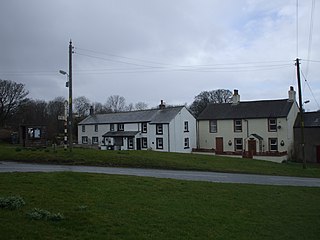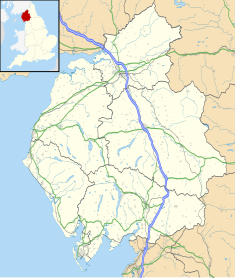
Workington is a coastal town and civil parish at the mouth of the River Derwent on the west coast in Cumbria, England. At the 2011 census it had a population of 25,207.

Cumberland is an area of Northern England which was historically a county and is now fully part of Cumbria. The county was bordered by Northumberland to the north-east, County Durham to the east, Westmorland to the south-east, Lancashire to the south, and the Scottish counties of Dumfriesshire and Roxburghshire to the north. The area includes the city of Carlisle, part of the Lake District and North Pennines, and the Solway Firth coastline.

Keswick is a market town and civil parish in the Cumberland unitary authority area of Cumbria, England. Historically, until 1974, it was part of the county of Cumberland. It lies within the Lake District National Park, just north of Derwentwater and four miles from Bassenthwaite Lake. The parish had a population of 5,243 at the 2011 census.

Cockermouth is a market town and civil parish in the Cumberland unitary authority area of Cumbria, England, so named because it is at the confluence of the River Cocker as it flows into the River Derwent. The mid-2010 census estimates state that Cockermouth has a population of 8,204, increasing to 8,761 at the 2011 Census.

Aspatria is a town and civil parish in Cumberland, Cumbria, England. The town rests on the north side of the Ellen Valley, overlooking a panoramic view of the countryside, with Skiddaw to the South and the Solway Firth to the North. Its developments are aligned approximately east–west along the A596 Carlisle to Workington road and these extend to approximately 2 miles (3.2 km) in length. It lies about 8 miles (13 km) northeast of Maryport, a similar distance to the Southwest of Wigton, about 9 miles (14 km) north of Cockermouth and 5 miles (8.0 km) from the coast and Allonby. It comprises the townships of Aspatria and Brayton, Hayton and Mealo, and Oughterside and Allerby, the united area being 8,345 acres (3,377 ha); while the town takes up an area of 1,600 acres (647 ha). In earlier days a Roman road leading from "Old Carlisle" to Ellenborough passed through the hamlet.

Allerdale was a non-metropolitan district of Cumbria, England, with borough status. Its council – Allerdale Borough Council – was based in Workington, and the borough had a population of 96,422 at the 2011 census.

Brigham is a village in Cumbria, England. The village is near to the town of Cockermouth and is located just outside the Lake District National Park.

Bassenthwaite is a village and civil parish to the east of Bassenthwaite Lake in Cumbria, historically part of Cumberland, within the Lake District National Park, England. According to the 2001 census it had a population of 412, increasing to 481 at the 2011 Census. There is a Church of England Church, St John's Bassenthwaite and a tiny Methodist chapel. The village contains many elements of the archetypal English village including a green, primary school and a stream that runs through it.

Bothel and Threapland is a civil parish in Cumbria, England, just outside the Lake District National Park. According to the 2001 census, it had a population of 438. The parish includes the villages of Bothel and Threapland. The village of Bothel is south-east of the parish of Aspatria and Threapland is south of Aspatria and Carlisle is eighteen miles (29 km) North-east of the parish. It had a population of 483 in the 2011 census figures.

Broughton Moor is a village and civil parish in Cumbria, England. It is situated on an extensive moor about 2 miles (3.2 km) north of Broughton, 5 miles (8.0 km) north west of Cockermouth, 2.5 miles (4.0 km) south of Maryport and 4.5 miles (7.2 km) north of Workington.

Greysouthen is a village and civil parish between the towns of Workington and Cockermouth, in Cumbria, North West England, historically part of Cumberland, near the Lake District National Park. The village has an historic association with coal mining.

Ireby is a village in the historic or traditional county of Cumberland, England, with a population of around 180. Between 1974 and 2023, it was in Allerdale district, Cumbria. Since April 2023, it is administered by Cumberland Council.

Fletchertown is a small village in the Allerdale borough of Cumbria, England. It was historically within Cumberland.

Great Broughton is a village and former civil parish, now in the parish of Broughton, in the Cumberland district, in the ceremonial county of Cumbria, England. It caters strongly for visitors. The estimated resident population was 1,823 in 2017.

Eaglesfield is a village in the parish of Dean in Cumberland in Cumbria, England. It is near the A5086 road, 2.5 miles (4 km) southwest of Cockermouth and is located just outside the Lake District National Park. In 1931 the parish had a population of 233.

Buttermere is a village and civil parish in the county of Cumbria, England.

Sunderland is a hamlet and former civil parish, within the Lake District National Park, now in the parish of Blindcrake in the Allerdale district of the county of Cumbria, England, historically part of Cumberland. In 1931 the parish had a population of 60.

Penrith Town Hall is a municipal building in Corney Square, Penrith, Cumbria, England. The structure, which was the headquarters of Eden District Council, is a Grade II listed building.

The Old Courthouse is a former judicial building on Main Street in Cockermouth in Cumbria in England. The building, which is currently vacant, is a Grade II listed building.




















